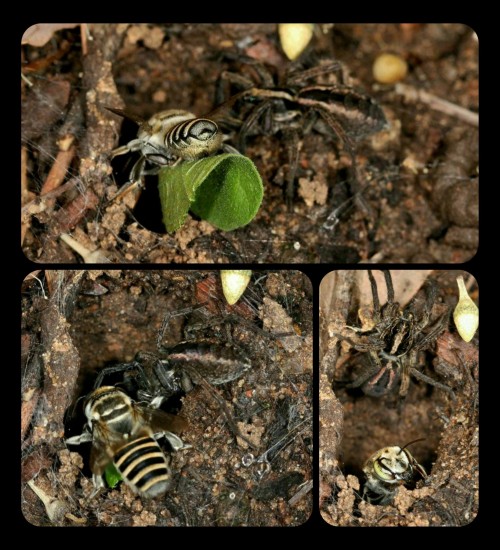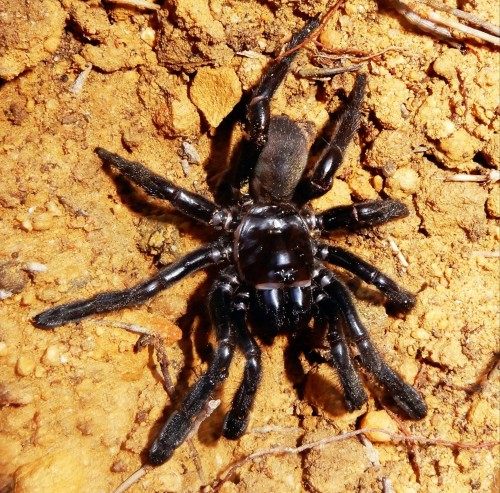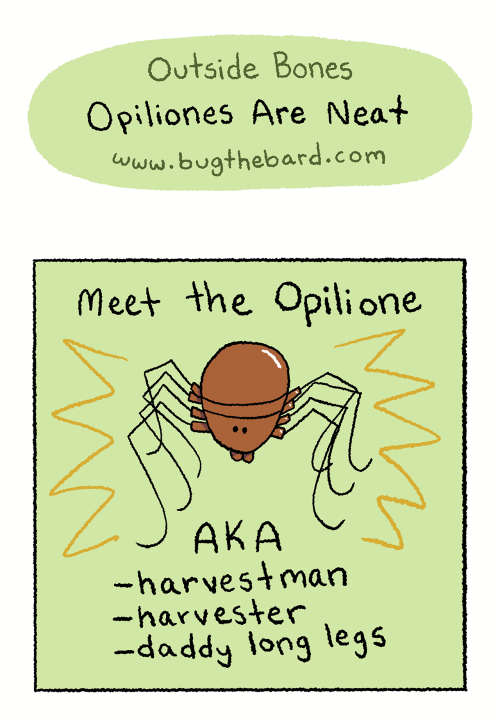Curate, connect, and discover
Bugs - Blog Posts



Rose Myrtle Lappet Moth (Trabala vishnou), family Lasiocampidae, Johor, Malaysia
photograph by Varun Thangamani
What a terrible world we live in where you can google wild plants or bugs because you're interested in them and the first results are all "how do I kill this"

today's bug thing is the Love Grub plush bag!
Moth Of The Day #212
Lily Moth / Indian Lily Moth
Polytela gloriosae
From the noctuidae family. They have a wingspan of about 29 mm. They are found in Sri Lanka and possibly Indonesia.


Image sources: [1] [2]
Moth Of The Day #251
Marbled Emperor
Heniocha dyops
From the saturniidae family. They can be found in Angola, Kenya, Namibia, South Africa and Tanzania.




Image sources: [1] [2] [3] [4]
Please could you show the world my favourite moth, Moma alpium, the Scarce merveille du jour? Its very special to me, and I hope others can appreciate it too.
Moth Of The Day #270
Scarce Merveille du Jour
Moma alpium
From the noctuidae family. They have a wingspan of 30-35 mm. They can be found in the Palearctic Realm.


Image sources: [1] [2]
Moth Of The Day #291
Larch Tolype / Larch Lappet Moth
Tolype laricis
From the lasiocampidae family. They can be found in eastern North America.


Image source: [1] [2]
Moth Of The Day #272
Coenobasis amoena
From the limacodidae family. There is little to no information recorded about this moth.


Image sources: [1] [2]
Abbott's Sphinx Moth: this caterpillar has a false eye on its rump; it mimics the features of a vertebrate's eye, and even includes a white reflection spot

The formal name for this species is Sphecodina abbottii.

From Minnesota Seasons:
The caterpillar is up to 3″ (7.5 cm) long. Middle stage (instar) caterpillars are whitish to bluish-green. In place of the horn found on other sphinx caterpillars, there is a raised orange knob on the eighth abdominal segment (A8). Final instar caterpillars come in two color forms. The brown color form has longitudinal streaks of light and dark brown mimicking the color of a woody vine. The green form has on each abdominal segment a large, pale green, saddle-shaped spot on the upper side and a similar smaller spot on each side. The pattern is said to mimic a bunch of unripe grapes. Both forms have a black, raised, eye-like knob on A8 complete with a small white spot mimicking reflected light.
When the caterpillar is pinched or poked, it often squeaks and bites at the attacker.
The fully-developed moth also has a unique appearance -- it has an ash-grey/blue coloration with streaks of pink and black.

Sources & More Info:
Encyclopedia of Life: Sphecodina abbottii
Insect Identification: Abbott's Sphinx Moth
University of Wisconsin-Milwaukee: Saukeville Field Station
Minnesota Seasons: Abbott's Sphinx Moth
University of Minnesota Garden Extension: Abbott's Sphinx
Vida's Sheep Jumping Spider: researchers believe that these tiny spiders developed their "woolly" appearance as a way to mimic lacewing larvae or scale insects

The scientific name for this species is Oviballus vidae, but it has also been referred to as the "sheepy jumping spider" or "Vida's jumping spider." It was discovered in 2015, and first described (in a formal context) back in 2020.

As this article (PDF) describes:
Recently, two new salticids, R. legitima and Oviballus vidae were described from South Africa, and suggested to be mimics of either scale insects (Hemiptera: Coccoidea) or lacewing larvae (Neuroptera: Chrysopidae), due to their white colouration and the presence of peculiar tufts of white setae on the body.

The possibility of [scale insects] being the model is supported by Oviballus vidae being regularly collected from plants with woolly scales, although the movements of O. vidae quite closely resemble those of chrysopid larvae.
In fact, a fourth species of possible scale mimic, a new Rhene species, was recently discovered in a collection of salticids from southern Mozambique, indicating that this phenomenon may be more widespread than has previously been known or even suspected.

O. vidae was named after Vida van der Walt, the photographer who captured some of the first images of these spiders back in 2015, just after the species was discovered by Dr. Galina Azarkina. Vida van der Walt also took the photographs that appear in this post.
Sources & More Info:
Arthropoda Selecta (scientific journal): Rediscovery and Redescription of Rhene cooperi, another possible mimic of scale insects (PDF)
Spider Club of South Africa: Two New Species Named After SA Photographer (PDF, with the relevant info on page 5)
Field Guide to the Spiders of South Africa: Section on Vida's Sheep Jumping Spider
why Do i have to Work A Job… why can’t i Just be little Bug… and munch on Leaf… oh the yearning…..

I was bored in class
Is it just me?
When I was younger I grew up 1 brother, but also many of his friends. Almost every summer until COVID, we would challenge one another to eat bugs. Even as a teenager (15), I thought almost everyone had eaten a bug once as a joke or a dare. Is it just me?
So...
Inktober is happening and already one week is done, yeah
I'm using this prompt list from Instagram

Here are the drawings
Day 1: Bones + forage
(This one was interesting to make

Day 2: Devil + sleep
(Used forgotten ocs of mine)

Day 3: Ghost + autumn
( My favourite so far)

Day4: Bugs + haunt
( I like this one)

Day 5: Clown + emotion
(Wanted to play with the lightning but forgot to use a reference hehe)

Day 6: Bottle + hobby
(I really hate this one)

today is my birthday!



Todays my birthday! My brother took me to see the dog man today and I really liked the movie! And im Super excited to have burgers for dinner!
cannot WAIT till it starts looking like this outside again

Apparently a part of the reason why farmed bees stay in the beehives that humans build for them is because the farm hives are safer and sturdier. I don't know how a busy Discord server's worth of bugs that only have one brain cell each would logically conclude that the humans protect them from outside threats, illness and parasites, but if I understood right, the bees would be free to move away and build a new nest somewhere else any time they'd want, and they simply choose not to.
You know how in almost every culture, people have some concept of "if I sacrifice something that I made/grew/produced to the Gods, they will ward me and my harvest from evil"?
So, in a way, don't the bees willingly sacrifice a part of their harvest to an entity not only far greater than them, but nearly beyond their comprehension, in exchange for protection against natural forces wildly outside of their own control?
So tell me, beekeepers, what are you to your bees, if not a mildly eldritch God?
People who like mantises but aren't that into entomology are always "orchid mantises" this and "orchid mantises" that. Overrated. Can we talk about Toxodera integrifolia for a minute:



(Image links because as much as it pains me I've never seen one of these beauties irl: 1 2 3)
Like how are these things real. Girl what is that thorax shape. Why are you wearing eyeliner. And the colors? Absolutely fire. This is a 10/10 insect if you ask me.
Rare images of a leafcutter bee sharing its nest with a wolfspider:

These photographs were taken in Queensland, Australia, by an amateur photographer named Laurence Sanders.

The leafcutter bee (Megachile macularis) can be seen fetching freshly-cut leaves, which she uses to line the inner walls of her nest. The wolfspider moves aside, allowing the bee to enter the nest, and then simply watches as the leaf is positioned along the inner wall.

After inspecting the nest together, they return to their resting positions -- sitting side-by-side in the entryway to the nest.
The bee seems completely at ease in the presence of the wolfspider, which is normally a voracious predator, and the spider seems equally unfazed by the fact that it shares its burrow with an enormous bee.
This arrangement is completely unheard of, and the images are a fascinating sight to behold.
Sources & More Info:
Brisbane Times: The Odd Couple: keen eye spies bee and spider bedfellows in 'world-first'
iNaturalist: Megachile macularis
things to say to bugs when science finally unlocks the secrets of human-bug communication:
im not hurting you i am taking you to a safe place
do you eat weird crumbs cause i found some im willing to share
you can bite me if you want but id rather be no-bite friends
i like your big colorful eyes, very stylish
please dont crawl into my sleeves
(sings a duet with a cricket)
today on the list of things that are gonna keep me up at night (courtesy of depthsofwikipedia ig)
![Number 16 (c. 1974 – 2016), also known as #16,[1] was a wild female trapdoor spider (Gaius villosus, family Idiopidae) that lived in North Bungulla Reserve near Tammin, Western Australia. She lived an estimated 43 years and became the longest-lived spider on record, beating a 28-year-old tarantula who previously held the title.[1] When Number 16 finally died in 2016, it was not of old age but from a parasitic wasp sting.[2]](https://64.media.tumblr.com/c4ec8d4557e996181a31e482074ef2c3/9b6ec5da395ba979-f3/s500x750/5d56f2becc9790a630d8260b0c27c4e96e50214b.png)
![Death.
On 31 October 2016, researcher Leanda Mason discovered Number 16's burrow in disrepair. The spider was gone. Evidence suggested she was killed by a parasitic spider wasp.[4] The silk plug of her burrow had been pierced by a parasitic spider wasp.[1] During a survey six months earlier, Number 16 had been alive.[1] “She was cut down in her prime [...] It took a while to sink in, to be honest," said Mason.[4] The spider's death received widespread publicity in late April 2018, with the publication of a research article in the journal Pacific Conservation Biology.[1] Based on the burrow fidelity of females of her species, the researchers concluded with a "high level of certainty" that Number 16 was 43 years old at the time of her death.[1]
After retiring, Barbara York Main moved to a care facility for Alzheimer's. Leanda Mason, who kept in contact with her mentor, said in 2018 that Barbara "remembers No. 16" but "forgets that she’s died."[5]](https://64.media.tumblr.com/ad40be8c7c70f2bb4876be219ca4d849/9b6ec5da395ba979-78/s640x960/518bc9ffcd2580ce3f19eeda7a9ba0b792c7d950.png)
I don't think this is actually her but this is a photo of a specimen from the same species that comes up when you search for her.

A reminder that humans can and do form years - DECADES - long relationships with creatures much smaller and much different than us.
Rest easy, Number 16. You were taken from us too soon.





























